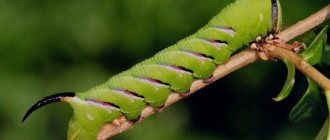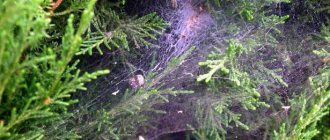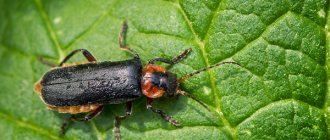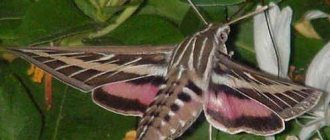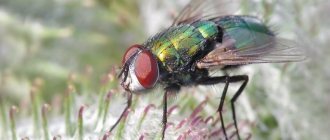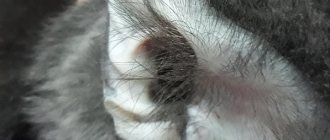Hawkmoth is a butterfly that looks like a hummingbird. She seems to be hovering over the flowers, quickly moving her wings. The colors of the representatives of this family are so diverse and original that it may be difficult to immediately guess which insect is in front of you. One of the main distinguishing features of the hawk moth is its long proboscis, which most often exceeds the size of the insect’s body. A video of the development of the caterpillar will be at the end of the article.
This unusually colored butterfly is a frequent hero of horror films and books. Why do superstitious people feel real trepidation at the sight of a small insect, and should summer residents who discover a hawkmoth pupa fear for their harvest?
In total, about 1,200 species of such butterflies are known, some of which are listed in the Red Book . In Russia you can see 50 species. How to understand that this is a hawk moth in front of you? Should you be afraid for the harvest if you find an uninvited guest at your summer cottage?
Description and appearance
The hawk moth butterfly is usually large or medium in size. Its body with a long proboscis of the Lepidoptera order has a cone shape at the end and is pointed, its wings are elongated and reach a span of 30 to 175 mm. The apices of the long antennae are pointed and hook-shaped. The eyes are round in shape and covered with a tuft of long scales. The proboscis is significantly longer than the body - it can be several times larger in size, but in some species it is short.
The leader in proboscis length among all insects is the butterfly Amphimoea walkeri. The proboscis of this South American species is sometimes 4 times larger than the body and measures 28 centimeters.
The hawk moth hovers over the flower.
The labial palps are curved upward. They are covered with scales on the outside, but there is no such covering on the inside. On the paws you can see short spines arranged in several rows. The abdomen has scales that gather at the end in the shape of a brush or tassel. The length of the hind wings is one and a half times greater than their width, and even in the photo a significant bevel towards the rear edge is visible to the naked eye.
Hawkmoth eggs are oval and measure approximately 1.5 by 1.2 mm. The color is usually pastel: it can be pale green or blue. The eggs are left on food plants, and the butterflies choose the underside of the leaves.
The hawkmoth caterpillar is distinguished by its large size, five pairs of legs and bright coloring - it is decorated with oblique stripes and spots resembling eyes, and individual hairs can be seen on the surface. Its length is initially up to 12 mm, while caterpillars of the fourth instar can grow significantly and be from 40 to 55 mm. Their weight is approximately 4 g.
Hawkmoths are real gourmets - they usually feed on either just one type of plant, or several, but closely related ones . You can see caterpillars both on trees and shrubs, most often in the dark - they are active in the evening and at night. However, some species are awake during the day.
The hawk moth pupa is distinguished by a characteristic elevation at the rear end, which is shaped like a horn. It is smooth and shiny. Weight varies from 7 to 12 g, color in the first hours after pupation ranges from yellow to cream, sometimes with a green tint, and later turns red. The pupal stage lasts about 30 days.
In the caterpillar stage
What does the hawk moth eat? Some species are pests that can cause harm to broad-leaved and coniferous trees in forests, and to stone fruit and fruit crops in gardens . But don't worry. The hawk moth caterpillar, although not beneficial, will not cause serious damage to the crop, and it is not worth fighting it.
This insect, similar to a hummingbird, is heat-loving. Most species are active migrants. The habitat is wide. Butterflies often move to other territories that are located north of the places where they were born. At the same time, hawk moths can easily overcome real obstacles on the way - for example, mountains that rise 3500 meters above sea level .
An inhabitant of Russian latitudes, who is often mistaken for an alien
Of course, at the very beginning I would like to talk about those types of large green caterpillars with horns that live in our country. The most common larva of the hawk moth and all its subspecies. For example, linden hawk moth. Its larva is a fairly long caterpillar. Sometimes it reaches 10 cm in length. Its color, unlike other caterpillars with horns, is quite calm and not particularly attractive. Most often, this insect is light beige or light brown in color with a white abdomen, on which there are horny growths, which are nothing more than the rudiments of the insect’s legs. They are quite hard and tenacious to the touch; thanks to these properties, the caterpillar can easily move along tree trunks. In rare cases, linden hawk moth larvae can be bright green or black with brown speckles. No matter what color the caterpillars are, they always have a sharp, hard spike on their tail, which many take for a horn, confusing the insect’s head with its tail.
Features and lifestyle
How to understand that this is a hawk moth butterfly? Pay attention to its features:
- Adults can be up to 11 cm in length, with a proboscis up to 10 cm.
- The speed of movement of the hawk moth is up to 50 km per hour.
- Butterflies have fantastic colors.
- The hawk moth larva reaches 12.5 cm.
- The horn comes in different colors depending on the type of insect.
- Before the pupa turns into a butterfly, a color change occurs.
- Hawkmoth looks like an alien creature - his “outfit” can be so unusual.
Social structure and reproduction
Photo: Hawkmoth butterfly from the Red Book
In their natural habitat, butterflies breed throughout the year. Offspring are hatched twice, sometimes three times under favorable climatic conditions. Mating most often occurs in the dark. It lasts from 20-30 minutes to several hours. Throughout this entire period, the insects remain motionless.
At one time, one female individual is capable of laying up to 150-170 eggs. The egg is round in shape and has a white color with a blue or green tint. Eggs are most often laid on forage vegetation. Subsequently, after 2-4 days, a light, milky-white larva with colorless legs appears from the eggs.
The caterpillar has several stages of development:
- the caterpillar is light green in color, the diameter of the caterpillar does not exceed 12-13 millimeters;
- a large brown horn is formed on the body, the size of which visually exceeds the size of the body;
- the caterpillar increases significantly in size, new signs appear;
- the formed horn becomes lighter and rougher. Stripes and dark spots appear on segments of the body;
- the size of the body increases to 5-6 centimeters, weight reaches 4-5 grams;
- the larva increases significantly in size. Weight reaches 20 grams, length – up to 15 centimeters.
Caterpillars are perfectly adapted to survive in various conditions. Depending on the species, they have a camouflage coloring that allows them to blend in with the vegetation. The caterpillars of some species have a streamlined shape, stiff bristles, or may emit an unpleasant odor that repels birds and other representatives of the animal world that eat the caterpillars.
After the caterpillar has accumulated sufficient nutrients and gained sufficient body weight, it sinks into the soil. There she pupates. At the pupal stage, the butterfly exists for 2.5-3 weeks. During this period, great changes occur in the body of insects. The caterpillar transforms into a butterfly. The beautiful butterfly frees itself from the cocoon, dries its wings, and goes in search of a mating partner in order to continue its life cycle.
Should summer residents be afraid of hawk moth?
The basis of the diet of this species is fragrant nectar . Therefore, in areas where there are many flowers and shrubs, they are more common. You can see how the hawk moth seems to hover over a flower in a flower bed. They appear in the garden extremely rarely - usually isolated cases are recorded. The population size changes significantly every year and largely depends on weather conditions. So in cold years there are significantly fewer hawk moths, and in warm years the number of insects increases sharply.
The caterpillars do not cause serious damage to plantings - they feed on young leaves, but not on a significant scale, so the plants quickly recover. The accumulation of such insects is very rare. Therefore, if you see a caterpillar, then there is no need to worry about the harvest; it is better to just carefully move it from your plot to the meadow, because this insect is listed in the Red Book.
Eating
Since ancient times, it has been believed that the hawkmoth moth is a harbinger of serious troubles. Most likely, the reason for such superstitious fears and hostility lies in the appearance of the butterfly. On the back of some species you can see an ominous pattern - as if a skull and crossbones are depicted on the body. To see what a hawkmoth looks like, you can search for photos using the query “hawkmoth moth photo.” The second reason, which has given rise to a lot of speculation, is the unpleasant squeak of an insect.
Are hawk moths harmful?
Adult hawkmoths feed on the nectar of flowers, so they not only do not harm, but also bring benefits by pollinating plants. Caterpillars eat young leaves, including those of vegetable crops, such as potatoes, tomatoes, and eggplants. However, the invasion of a large number of hawkmoth caterpillars is a very rare case. And several individuals that have settled in the garden do not cause serious damage to the plants; they are easily restored. So the hawk moth can hardly be considered a pest of agricultural crops.
Hawkmoths in culture
For superstitious people, meeting a hawk moth is a frightening event. A butterfly called "death's head" has become the heroine of creepy legends and stories. This insect has been blamed for disease, death and even war. Some beliefs are still alive - the Mexicans believe that if a scale from a hawk moth's wing accidentally gets into the eye, you can even go blind.
Mentions of the scary butterfly can be found in books and films. So in the film “The Silence of the Lambs” by Jonathan Demme, a maniac puts a hawkmoth pupa into his victims’ mouths. In the novel on which the film was based, a different species was chosen - Acherontia styx, but in the film we see the death's head hawkmoth.
Edgar Poe mentions this butterfly in the story “The Sphinx” - where the insect was crawling along the web on the window. Alexander Belyaev refers to the same creepy image in the story “The Death's Head”.
Van Gogh called one of his works “Death's Head Hawkmoth.” However, he mistakenly depicted another butterfly, called the Pear-Eyed Peacock. A new name was given to the painting at the Artist's Museum in Amsterdam, renaming it “Imperial Night Butterfly”.
How long does this butterfly live?
The hawk moth insect does not live long. Its life cycle consists of four phases. First, the female must lay an egg, from which a larva emerges after 2-4 days. The caterpillar turns into a pupa, and later an adult is born. To attract the attention of the male, a special pheromone is released. After mating, which lasts several hours, the butterfly lays eggs on the plants.
The lifespan of these insects varies depending on the species:
- the tobacco hawk moth lives for about a month;
- some species live only a few days and die after new eggs are laid. At the same time, they feed on the reserves that were made earlier. The full classification of butterflies is here.
Features of reproduction
Hawkmoths mate while sitting on a branch or in the air. This process lasts from 35-60 minutes. To lay eggs, the fertilized female chooses plants that the caterpillars can feed on. Their food crops are bedstraws (a family of shrubs and grasses). But hawkmoths also love chickweed, which is presented in the form of a flowering plant from the carnation family. Almost all of these herbs are weeds that contain toxic substances.
READ ALSO: Products to increase egg production of laying hens
A fertilized butterfly lays one egg at a time, fixing it with a special adhesive substance to the stem or leaf of the plant. The diameter of one such egg is only 1 mm, it is painted light green, and the surface is glossy. The larva is born after 5-8 days. At the time of birth, its length does not exceed 4 mm. Initially, the larvae are yellow, but already at the second stage of life the color becomes green, and the entire body is covered with yellow dots. They eat a lot and grow quickly.
Initially, the caterpillars eat the upper part of the plant. After five instar cycles, the larva turns red, descends to the ground and pupates. Under favorable conditions and sufficient nutrition, the butterfly appears in three weeks.
The pupae are brown in color and their length varies from 25 to 35 mm. The proboscis is marked by a keel-shaped convexity. The main enemies of moths are:
- Tahini. Diptera insects that are considered internal parasites of butterflies.
- Braconids. These are ichneumon wasps that live in large numbers in different parts of the world. They lay their eggs on caterpillars.
Hawk Moth Breeding
Hawkmoth butterflies of most species are easily bred in captivity. Usually an aquarium is installed at home, with branches of deciduous trees placed inside it. The caterpillars are planted on them. Soil and pebbles are placed at the bottom. In winter, the bottom of the aquarium is covered with sphagnum or wet sawdust. For hatching, the aquarium must be illuminated for at least 14 hours a day. The required humidity is maintained using a spray bottle. Read more about what a Butterfly Farm is.
Types of hawk moths
Wine hawkmoth (also called "grape hawkmoth" or "rose hawkmoth") is found on grapevines. This species is distinguished by its bright color, large size and sharp spine.
The lilac hawk moth is one of the largest butterflies that adorns the hawk moth family. Its wingspan ranges from 90 to 120 mm . The hind wings are colored pink, and rings can be seen on the abdomen, some of which are also pink, while others are brown. The lilac hawk moth differs from other species in its proboscis - its length is approximately the same as the insect’s body. The caterpillar can be of two colors - green or purple.
Hawkmoth is a hummingbird of the middle zone. Indeed, as you can see from the photo, it won’t be difficult to find common features between a butterfly and a bird. It's a joke of nature - hummingbirds are the tiniest birds, their weight is usually no more than 2 g, and hawk moths are the leaders among butterflies in size. While feeding, insects do not sit on flowers, but seem to hover over them, quickly flapping their wings. It seems that a tiny bird is hovering over the bud. In central Russia, one of the most common species is the bedstraw hawk moth.
The linden hawk moth is easily recognizable due to its front wings with jagged edges, the span of which can be from 60 to 80 mm. And here we have photographs of the largest butterflies in the world. Color ranges from olive green to rust with irregular dark spots. The hind wings are yellow ocher. The caterpillar of this species is green with red and yellow stripes. You can see it in summer on birch, alder and linden trees.
The moth hawk moth is not protected from the dangers that await it in its natural habitat everywhere. For example, wasps and moths can lay eggs on the surface of the body of a butterfly or pupa. The emerging parasites use the internal organs of the hawk moth as food. The night hawk moth can also be killed by chemical insecticides used by humans, as well as be eaten by birds. Therefore, the insect is forced to defend itself, sometimes using unusual methods. For example, a hawkmoth larva can easily feign death during a bird attack. By the way, here is a list of all moths.
Sometimes caterpillars take threatening poses to scare away enemies - the front part of the body rises menacingly, the insect freezes in this pose. In case of danger, the hawkmoth butterfly can strongly inflate its abdomen.
general information
Hawkmoths are amazing insects: outwardly, adult individuals resemble hummingbirds. Some species of nocturnal butterfly fly only during the day, others are active at night or in the morning. When an unusual creature with an original body and wing color appears in a garden or vegetable garden, many owners do not understand what type of butterfly it is.
Characteristics:
- the size of adult insects is up to 110 mm, the proboscis is up to 100 mm long, the wingspan is from 65 to 120 mm;
- the flight speed is impressive - up to 50 km/h;
- hummingbird butterflies hover over flowers, flutter, quickly flap their wings, and feed on sweet nectar;
- the complete cycle of transformation is characteristic of unusual creatures. First, the egg appears, then the larva (caterpillar), then the pupa and finally the adult (butterfly). The life cycle takes from 30 to 45 days; during the summer period, two generations of amazing creatures often alternate;
- The emergence of adult insects begins at the end of June. Bright creatures look spectacular against the backdrop of young greenery. Butterflies flutter around flowering trees and shrubs: pear, apple, chestnut, lilac;
- The caterpillars are large - up to 125 mm, most species have a bright color, and the original pattern on the back and sides is often noticeable. Some species are painted in fantastic colors: green with a lemon tint, white with black and yellow spots on the sides, brownish-gray with “painted” eyes on the front of the body. Growing individuals look like creatures from another planet;
- A characteristic feature of caterpillars is a “horn” at the end. The color of the formation depends on the type of butterfly, for example, in the lilac hawkmoth it is black on one side and yellow on the other, in the ocellated variety it is blue;
- Before pupation, the color of the growing insect changes. During this period of development, the caterpillar accumulates enough nutrients and then burrows into the ground. After 18 days, a beautiful butterfly emerges from the pupa. While the wings dry, the insect sits in place, as soon as it can fly, the hummingbird butterfly goes to look for a sexual partner to maintain the population;
A few more facts:
- A caterpillar is a creature that is soft to the touch, calm, and crawls quite slowly. If you take it in your hands, no unpleasant sensations or disgust appear. The growing individual sits calmly on the palm, moves slowly, and willingly “poses” for the camera.
- caterpillars feed on young leaves. The wine hawk moth eats greenery and settles on the grapevine. The larva is large, warlike in color, and has a kind of spike at the end. The creature is so unusual that many owners do not destroy the pests, but watch them, hoping to endure the unpleasant period and later see a beautiful hummingbird butterfly on the site;
- The tongue hawk moth resembles a small bird. When a beautiful creature appears at their summer cottage, many children say that they saw an unusual bird next to the flowers;
- The Death's Head Hawkmoth gets its name from its distinctive skull-like pattern on its chest, like the emblem on a pirate flag. The largest butterfly of the hawkmoth species feeds on the sap of young trees and honey. The insect often climbs straight into the hive, makes sounds reminiscent of a young queen, and steals honey without hindrance: the bees take her for a relative and do not touch her;
- the bedstraw species is most often found in the middle zone. Long proboscis, dense body, color - a combination of brown and beige, with orange areas visible on the tips of the wings.
Unusual insects are often called sphinxes. The reason is that the disturbed caterpillar raises its front part, takes on a threatening appearance, and freezes in the pose of a sphinx. Hence the name.
Types of hawk moths:
- euphorbia;
- wine;
- pine;
- hawkmoth "death's head";
- ocular;
- oleander;
- bindweed;
- lilac;
- proboscis hawk moth and others.
On a note!
There are about 1,000 species of “northern hummingbirds” on the planet. Some species make long-distance flights, migrate from one end of the country to another, or cover distances between continents.
Interesting facts about hawk moths
Hawk Moth is distinguished not only by its bright and memorable coloring. Some facts about this insect are amazing:
- The death's head butterfly is a real intruder in the world of insects. The hawk moth robs the bees - it flies up to the hive and begins to buzz characteristically, then pierces the honeycomb with its proboscis and feasts on honey. But sometimes the bees understand the trick, pounce on the robber, bite him to death and then mummify him in the hive.
- Another feature of the species is that in times of danger it begins to squeak loudly and desperately.
- In a minute, an insect can cover a distance that is 25 thousand times greater than its body.
- In the Middle Ages, the lilac hawk moth was terribly feared because it was considered a harbinger of death.
- From Latin the name of the wine hawkmoth (“porcellus”) is translated as “piglet”. From a distance, the insect appears to be completely pink.
The “scorching rose” does not grow in the garden, but eats it
Another beautiful caterpillar that lives overseas and poses a certain danger to people is the “stinging rose.” It received its name not for the single horn on a very small body (only 2.5 cm), but for the poisonous thorns abundantly located on it. If you touch it, you are guaranteed to experience serious skin irritation. A distinctive feature of this green caterpillar with horns is longitudinal orange and black stripes, as well as bright red and yellow spots on the body. Looking at it, it becomes clear why scientists classify the most beautiful and unusual insects as especially dangerous.
Hawk Moth Guard
The diversity of hawkmoth species is amazing, but the population is declining. This is influenced by a number of factors:
- the number of birds that feed on caterpillars is increasing;
- bushes are cut down and grass is burned;
- feed crops are treated with substances that are toxic to butterflies.
In Russia, the most favorable conditions for hawk moths are in the Transcaucasus - thanks to the mild climate, the pupae endure winter more easily. Hawkmoths were included in the Red Book back in 1984.
In some regions where butterflies are critically endangered, insecticide use is being reduced. In addition, the number of plants burned is limited, because they may contain hawkmoth pupae. These simple but effective measures can save rare species and help increase the number of beautiful species.
Where does the hawk moth butterfly live?
Photo: Hawkmoth butterfly in nature
This species of Lepidoptera is a heat-loving insect. Despite the wide variety of subspecies, most of them are concentrated in tropical countries. Some subspecies can be found in the temperate zone of the earth.
Butterfly habitat:
- North America;
- South America;
- Africa;
- Australia;
- Russia;
- Eurasia.
No more than fifty subspecies live on the territory of Russia. Most butterfly species choose areas with dense vegetation as their habitat. However, there are subspecies that inhabit the desert regions of Eurasia. Most species of hawk moths are considered moths. Therefore, during the day they are mainly found on the bark of trees and bushes.
Hawkmoths are cold-blooded insects, so before flying they flap their wings for a long time and quickly, heating their body to the desired temperature. In the tropics, hawk moths fly all year round. In temperate latitudes they survive winter in the pupal stage. To survive in the oncoming cold weather, the pupa hides in the soil or moss.
Some species migrate with the onset of cold weather to warmer countries. There are species that, on the contrary, migrate with the onset of summer to more northern regions. Migration is associated not only with climate change, but also with overpopulation of the habitat. In new regions, they create temporary colonies and breed offspring.
Now you know where the hawk moth butterfly lives, let's find out what it eats.





